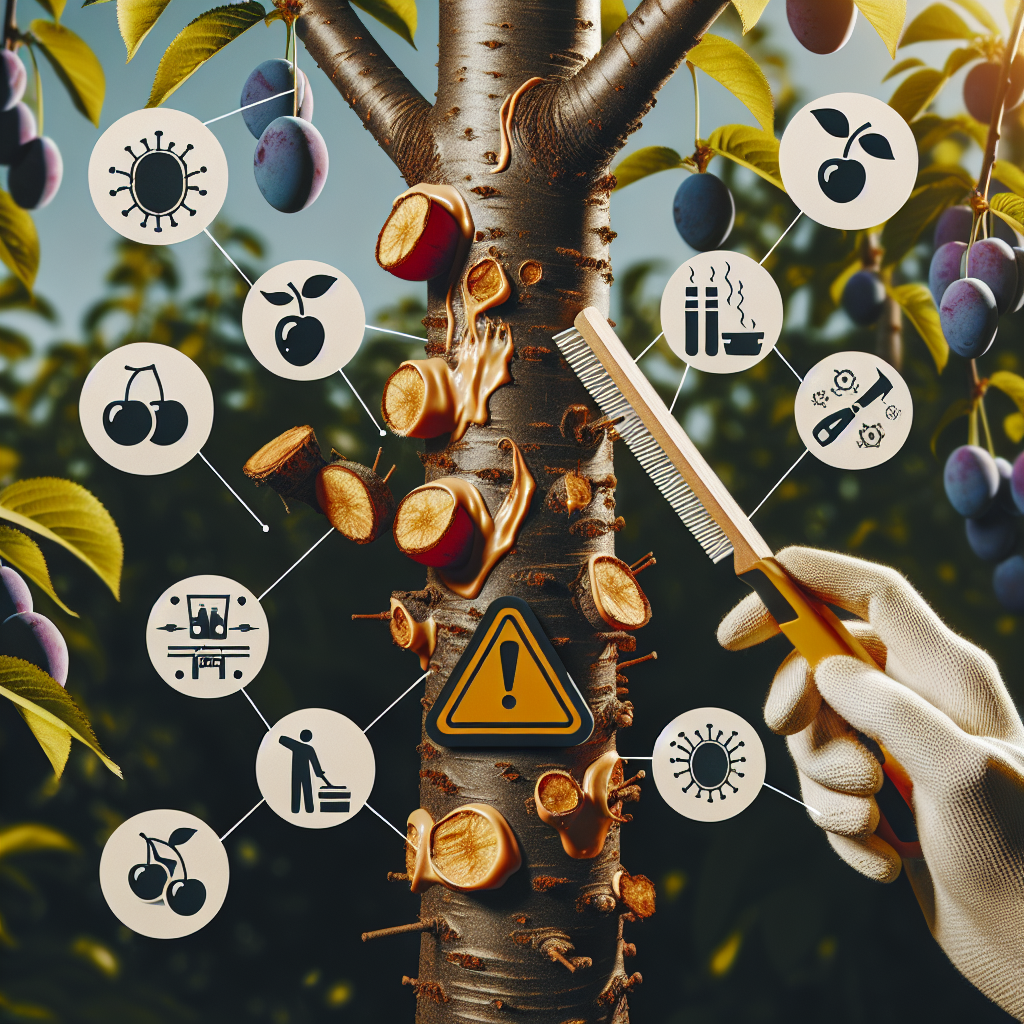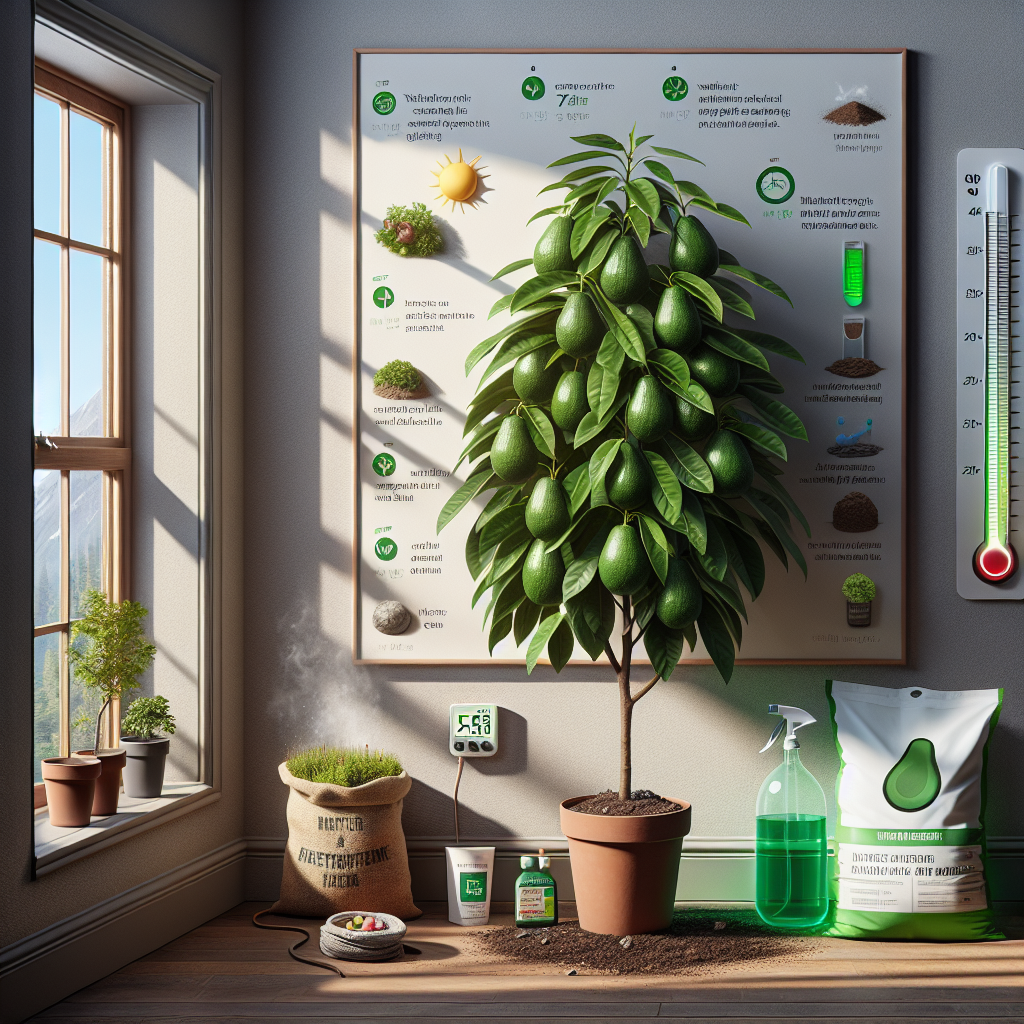Preventing Gummosis in Cherry and Plum Trees
Updated June 29, 2024 at 2:18 am
Explore effective strategies to protect your cherry and plum trees from gummosis, the oozing disease that can compromise their health and fruit production, ensuring a thriving and bountiful orchard.

Understanding Gummosis in Cherry and Plum Trees
When you stroll through your garden, noticing the cheerful blossoms of your cherry and plum trees, the last thing you want to see is gummosis afflicting these delightful arboreal companions. Gummosis, the oozing of sap from the tree’s bark, can indicate various issues, from environmental stresses to disease. But what exactly causes this problem, and how can you prevent it?
Firstly, gummosis can be a reaction to physical damage or a fungal infection like Cytospora canker or bacterial canker, which can seriously affect stone fruit trees. Being proactive in its prevention not only preserves the aesthetics of your cherished trees but also their health and productivity.
Early Detection and Identification
Regular monitoring is the first step towards prevention. You might be noticing some gum-like substance seeping through the bark of your cherry or plum tree—this is a tell-tale sign. However, not all gummosis cases are equal. Pinpointing the cause early on can make all the difference in effective treatment and prevention.
While inspecting your stone fruits, if you spot lesions or cankers on the branches or trunk from which the gum is oozing, it could signal a fungal issue, potentially bringing your pollinator-friendly garden to risk as well.
Proactive Care and Cultural Practices
Caring for cherry and plum trees requires a holistic approach. You want to ensure optimal growth conditions to help your trees resist and recover from gummosis more effectively. This can encompass adequate watering, fertilization, seasonal pruning, and ensuring the tree is planted in well-draining soil to discourage root rot.
Little things like watering your trees deeply, but infrequently, can encourage a strong root system, and this could also be a shared practice for successful winter vegetable gardening. So, it’s a win-win for your garden’s diversity.
Choosing Resistant Varieties
If you’re just starting out or looking to add new trees to your garden, it’s wise to select cherry and plum varieties that demonstrate greater resistance to diseases like bacterial canker, which often lead to gummosis.
Starting with a strong genetic foundation can vastly decrease your overall maintenance and worry. Researching the most resilient varieties suits not only your gardening zone but the specific microclimate of your garden will pay dividends in disease prevention.
The Role of Proper Pruning
Regular pruning is essential for maintaining the health of cherry and plum trees, and therefore preventing gummosis. It allows for better air circulation and sunlight penetration, which are key to avoiding fungal diseases. Always use clean, sharp tools to make precise cuts and minimize trauma to the tree.
Pruning should be carried out in late winter or early spring for optimal results. However, removal of diseased branches should be done as soon as they’re noticed, regardless of the season, to prevent the spread of pathogens.
Effective Fungicides and Treatments
Should your cherry or plum trees contract a fungal disease that causes gummosis, fungicides may be required. Products containing copper are frequently recommended for their effectiveness in combating bacterial and fungal pathogens. A product like Bonide Liquid Copper Fungicide is widely acclaimed for its efficacy. According to reviews, it’s user-friendly and effective when used as directed.
The key with fungicides, as reviewers often suggest, is prompt and correct application. Make sure to follow the guidelines carefully for the best results. For this particular product, you would typically apply it when the tree is dormant, just before spring growth begins, for preventive measures.
Pros
- Highly effective against a wide range of plant diseases
- Can be used as both a preventative measure or treatment
- Generally considered safe when used as directed
Cons
- Requires adherence to strict application guidelines
- Overuse can lead to copper accumulation in the soil
- Not effective against all strains of pathogens
Find This and More on Amazon
Healing and Recovery
Managing gummosis also involves aiding your cherry and plum trees’ healing process. If the cause is a wound, clean the area with water, remove any dead bark to expose living tissue, and allow it to air-dry. This may help the tree to compartmentalize the wound and recover more effectively.
For canker diseases, after you remove the infected regions, you might also apply a tree wound dressing. Products such as Tanglefoot Tree Pruning Sealer are often recommended in reviews for this purpose—albeit with some debate among gardeners regarding their necessity and effectiveness.
Integrated Pest Management (IPM)
IPM is a sustainable approach to managing pests which combines different strategies and practices. It involves regular monitoring, using resistant plant varieties, appropriate cultural practices, and, if necessary, using pesticides judiciously.
When applying IPM in your garden, getting the most from your vegetable garden can also become more manageable, as it entails a similar set of principles for pest and disease control.
Hygiene and Sanitation
Hygiene and sanitation matter greatly in preventing diseases like those that cause gummosis in your cherry and plum trees. Ensure that you remove any fallen leaves, fruit, or pruned branches from around the trees, as these can harbor pests and diseases.
Sanitizing your pruning tools before and after each use will also prevent the spread of potential pathogens. A simple solution of one part bleach to nine parts water is usually adequate for sanitizing your tools.
Soil Health and Nutrient Balance
Healthy, balanced soil is the foundation of plant health. Test your soil regularly to ensure it has the right pH and nutrient levels for your cherry and plum trees. Adjusting the soil’s pH or nutrient content can help prevent issues that weaken trees and make them more susceptible to gummosis.
Amending the soil with organic matter not only improves texture and nutrient content but also promotes beneficial microbial activity which can enhance the tree’s natural defense mechanisms against pathogens.
Water Stress and Drought Management
Extreme water conditions—either too much or too little—can be a stressor for trees and make them more vulnerable to gummosis. Maintaining a consistent watering schedule during dry spells is essential, especially for young trees that haven’t yet established extensive root systems.
Conversely, in areas with heavy rainfall or poor drainage, ensuring the planting site is adequately prepared to prevent standing water is crucial. Trees experiencing waterlogged conditions are prime targets for root rot and subsequent gummosis.
Conclusion
Gummosis can be a daunting concern for gardeners, but with diligent care and preventive measures, its impact can be mitigated. Remember to stay attentive to your trees’ needs, react promptly to signs of distress, and cultivate a nurturing environment to foster resilience against this condition.
Combining these strategies with products that come highly recommended by fellow gardeners, like the Bonide Liquid Copper Fungicide, can be your best defense. Ultimately, the vitality of your cherry and plum trees rests upon the foundation of a mindful, proactive gardening approach. Keep up the good work, and here’s to a lush, gummosis-free garden!
Maintaining Optimal Tree Health
Preserving the health of your cherry and plum trees is the best way to guard against gummosis. Maintaining a strong, viable tree through proper care and response to environmental conditions will reduce stress factors that can lead to the development of this condition.
For example, protecting trees from extreme temperatures by using mulch can help to regulate soil temperature and retain moisture, which is beneficial during both winter cold spells and sweltering summer heat.
Biocontrol Methods
In the pursuit of a chemical-free garden, biological control methods can be considered for keeping potential pathogens at bay. The introduction of beneficial insects or the application of biologically based products can be an eco-friendly, sustainable alternative.
Beneficial microorganisms, for instance, can suppress soil-borne pathogens and are less disruptive to the environment, which also aligns with creating a pollinator-friendly garden.
Understanding Cytospora Canker
One of the chief culprits behind gummosis in cherry and plum trees is Cytospora canker. Understanding this disease, its symptoms, and methods of control can significantly help with the prevention of gummosis.
If you’re grappling with this, it’s important to recognize the hallmark sunken, discolored cankers on the bark and branch dieback. Preventing wounds on the tree and ensuring good overall tree health are crucial steps in avoiding Cytospora canker.
Challenges of Bacterial Canker
Bacterial canker, caused by Pseudomonas syringae, is another significant disease that leads to gummosis. Being diligent about prevention and control is essential, as this disease thrives in moist, cool environments typically found in spring and fall.
Improving air circulation by appropriate pruning and selecting well-draining planting sites can minimize the conditions bacterial canker favors, thus helping prevent gummosis related to bacterial infections.
Expert Opinions and Extension Services
Don’t forget that your local cooperative extension service is a valuable resource when it comes to managing garden issues like gummosis. These services can provide localized advice that’s scientifically based and specific to your region.
Connecting with a local horticulturist or arborist can also give you the benefit of their expertise, particularly in choosing resistant varieties and adopting best practices for the care of your plum and cherry trees.
Monitoring Tree Vigor
Tree vigor is an often overlooked aspect that significantly affects the likelihood of disease and pest pressures, including those that cause gummosis. Vigorous trees are better equipped to ward off diseases and heal from wounds or infections.
Ways to enhance vigor may include adjusting soil nutrients, providing sufficient water, and managing competition from surrounding vegetation, harnessing techniques seen in successful winter vegetable gardening to support vitality in more vulnerable seasons.
Frequently Asked Questions about Gummosis
You might wonder if the sap oozing from the tree can spread the disease to others. While the sap itself does not spread disease, it can attract pests that harbor pathogens—a reason why maintaining a clean environment around affected trees is crucial.
Another question is whether all trees that exude sap are suffering from gummosis. In some cases, trees may naturally exude small amounts of sap due to environmental factors, not necessarily indicating disease or distress.
Review: Tanglefoot Tree Pruning Sealer
When discussing treatments, Tanglefoot Tree Pruning Sealer frequently appears in gardener’s conversations. According to reviews, this product acts as a protective sealant, preventing moisture and pathogens from entering the tree through pruning cuts.
It is said that people find it to be an easy-to-use product with the capability of helping trees to safely heal after being pruned. This can be a vital step in mitigating the risks associated with open wounds, one of the leading causes of gummosis in cherry and plum trees.
Pros
- Forms a protective barrier over pruning cuts
- Helps prevent infection and decay at the wound site
- Easy to apply with a brush or applicator
Cons
- Some debate over the necessity of using wound dressings
- Potential for misapplication leading to trapped moisture
- May not be suitable for all types of trees or pruning techniques
Stress Factors and Tree Wound Response
Stress factors are often a precursor to tree wounds and subsequent gummosis. Whether from mechanical damage, environmental extremes, or improper care, stress can weaken the tree’s natural defenses, making it more susceptible to pathogens.
Understanding how a tree responds to wounds can also inform your care strategy. Trees have a natural process called compartmentalization that helps to isolate and heal wounds. Enhancing this ability through good care practices is a step in preventing gummosis.
Review: Bonide Liquid Copper Fungicide
Combatting pathogens at the first sign of disease is critical to preventing gummosis. Bonide Liquid Copper Fungicide comes up time and again in discussions among gardeners. It’s touted for its wide-spectrum effectiveness against many fungal and bacterial diseases, including those that lead to gummosis.
Based on reviews, it seems that when used as prescribed, it effectively helps curb existing infections and provides protection against future outbreaks. Gardeners frequently note its ease of use and reliability in different environmental conditions.
Pros
- Wide-spectrum fungal and bacterial control
- Act as both a curative and preventive treatment
- Favorable safety profile when used according to the label
Cons
- Must be applied with caution to prevent overuse
- Not a silver bullet against all pathogen strains
- Timing and frequency of application are critical for effectiveness
Utilizing Natural Remedies for Gummosis Prevention
Natural remedies can be a gentle yet effective way to prevent gummosis in cherry and plum trees. For instance, compost tea might be a wise addition to your garden regimen to help boost your tree’s immune system and suppress potential pathogens in the soil.
Similarly, making sure you maintain a biodiversity in your garden can lead to a more robust ecosystem, which can naturally keep pest populations under control, a concept that also underpins the idea of creating a pollinator-friendly garden.
Community Involvement and Support Networks
Gardening is often a communal effort, and building a support network can be indispensable when dealing with tree diseases like gummosis. Joining local gardening clubs or online forums can provide a wealth of shared knowledge and experiences.
These collective resources can offer insights into what has worked for others in your area, adding to your toolkit for preventing and managing gummosis in your cherry and plum trees.
Emphasizing Environmental Responsibility
Treating plants with any form of pesticide should always be handled with environmental responsibility in mind. Consider whether a treatment is necessary and look for options that have the least impact on the surrounding ecosystem.
This approach not only aids in preserving the health of your trees but also maintains the delicate balance of your local environment, critical for all forms of life including beneficial insects and microorganisms.
The Value of Diverse Planting
Diverse planting in your garden can play a role in gummosis prevention. A variety of plants can offer a level of protection to your cherry and plum trees by creating a more balanced ecosystem that is less susceptible to the spread of disease.
Furthermore, diversity in planting may support your trees’ overall health, similar to the way an array of indoor plants enables thriving aglaonema with low light care techniques.
Conclusion
In conclusion, preventing gummosis in cherry and plum trees is a multifaceted approach that requires attention to detail, proactive care practices, and an understanding of the potential causes. With regular maintenance, proper cultural practices, and the choice of disease-resistant varieties, you can significantly reduce the risk of gummosis affecting your beloved fruit trees.
And, with the support of a community, whether local or virtual, and the consideration of eco-friendly options for disease prevention, you’re not just caring for your trees; you’re also contributing to a healthier, more sustainable gardening practice. Happy gardening, and here’s to healthy, beautiful trees in your garden!
Shop more on Amazon
Flowers & Plants Team
Flowers & Plants Team


